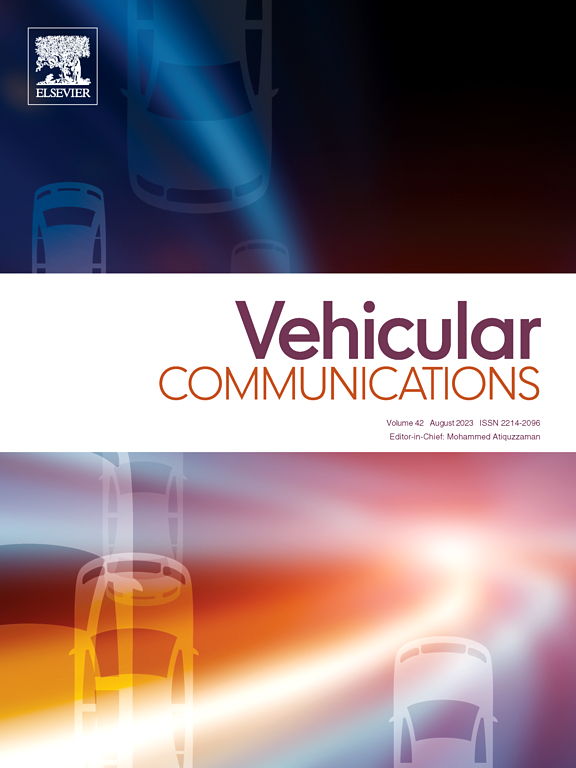Energy-harvesting relay-assisted STAR-RIS-enhanced vehicular NOMA networks
IF 6.5
2区 计算机科学
Q1 TELECOMMUNICATIONS
引用次数: 0
Abstract
The integration of simultaneous transmitting and reflecting reconfigurable intelligent surface (STAR-RIS) with non-orthogonal multiple access (NOMA) technology represents an effective approach for enabling massive device connectivity and achieving 360° network coverage. Under the NOMA scheme, the communication performance of weak users can be significantly enhanced, thereby improving user fairness; however, this often comes at the cost of performance degradation for strong users. Therefore, an energy harvesting relay-assisted STAR-RIS enhanced vehicular NOMA network is considered in this paper. Specifically, the paper provides a detailed analysis of the signal-to-noise ratio (SNR) at the near and far vehicles within the STAR-RIS-assisted vehicular NOMA network. The channel gain from the base station to the near vehicle via STAR-RIS and the composite channel gain between the base station and the far vehicle are approximated using Gamma distributions, with the accuracy of these approximations validated through Monte Carlo simulations. Based on the end-to-end SNR and the statistical characteristics of the channels, closed-form approximate expressions for the outage probabilities of near and far vehicles are rigorously derived, where the direct communication link exists between the far vehicle and the base station, while the energy-harvesting relay provides an auxiliary communication for the near vehicle. All analytical results are validated through simulations. The numerical and simulation results show that, without increasing the number of STAR-RIS elements, the outage performance of the near and far vehicles can be effectively controlled by adjusting the power allocation at the base station and the reflection/transmission coefficients of the STAR-RIS elements. This approach promotes fairness among vehicle users. Moreover, comparison with the orthogonal multiple access (OMA) scheme demonstrates that NOMA achieves better fairness between vehicle users and significantly reduces the outage probability for the far vehicle. Additionally, the energy-harvesting relay helps alleviate the negative impact of NOMA on the near vehicle, thereby further enhancing its communication stability.
能量收集中继辅助star - ris增强型车载NOMA网络
同时发射和反射可重构智能表面(STAR-RIS)与非正交多址(NOMA)技术的集成代表了实现大规模设备连接和实现360°网络覆盖的有效方法。在NOMA方案下,弱用户的通信性能可以显著增强,从而提高用户公平性;然而,这通常是以强大用户的性能下降为代价的。因此,本文考虑了一种能量收集中继辅助的STAR-RIS增强型车载NOMA网络。具体而言,本文详细分析了star - ris辅助车辆NOMA网络中远近车辆的信噪比(SNR)。利用伽玛分布近似计算了通过STAR-RIS从基站到近车的信道增益以及基站与远车之间的复合信道增益,并通过蒙特卡罗模拟验证了这些近似的准确性。基于端到端信噪比和信道的统计特性,严格推导了远端车辆与基站之间存在直接通信链路,而能量收集中继为近端车辆提供辅助通信的近端车辆中断概率的封闭近似表达式。通过仿真验证了所有分析结果。数值和仿真结果表明,在不增加星- ris单元数量的情况下,通过调整基站功率分配和星- ris单元的反射/透射系数,可以有效地控制近端和远端车辆的中断性能。这种方法促进了车辆使用者之间的公平。此外,与正交多址(OMA)方案的比较表明,NOMA方案在车辆用户之间实现了更好的公平性,显著降低了远端车辆的中断概率。此外,能量收集中继有助于减轻NOMA对附近车辆的负面影响,从而进一步提高其通信稳定性。
本文章由计算机程序翻译,如有差异,请以英文原文为准。
求助全文
约1分钟内获得全文
求助全文
来源期刊

Vehicular Communications
Engineering-Electrical and Electronic Engineering
CiteScore
12.70
自引率
10.40%
发文量
88
审稿时长
62 days
期刊介绍:
Vehicular communications is a growing area of communications between vehicles and including roadside communication infrastructure. Advances in wireless communications are making possible sharing of information through real time communications between vehicles and infrastructure. This has led to applications to increase safety of vehicles and communication between passengers and the Internet. Standardization efforts on vehicular communication are also underway to make vehicular transportation safer, greener and easier.
The aim of the journal is to publish high quality peer–reviewed papers in the area of vehicular communications. The scope encompasses all types of communications involving vehicles, including vehicle–to–vehicle and vehicle–to–infrastructure. The scope includes (but not limited to) the following topics related to vehicular communications:
Vehicle to vehicle and vehicle to infrastructure communications
Channel modelling, modulating and coding
Congestion Control and scalability issues
Protocol design, testing and verification
Routing in vehicular networks
Security issues and countermeasures
Deployment and field testing
Reducing energy consumption and enhancing safety of vehicles
Wireless in–car networks
Data collection and dissemination methods
Mobility and handover issues
Safety and driver assistance applications
UAV
Underwater communications
Autonomous cooperative driving
Social networks
Internet of vehicles
Standardization of protocols.
 求助内容:
求助内容: 应助结果提醒方式:
应助结果提醒方式:


